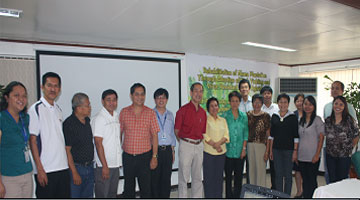 In an inception meeting held recently at the Philippine Council for Agriculture, Aquatic and Natural Resources Research and Development (PCAARRD), projects on rehabilitating the abaca plantation and commercial production of antisera for abaca bunchy top virus (ABTV) were formally launched for implementation.
In an inception meeting held recently at the Philippine Council for Agriculture, Aquatic and Natural Resources Research and Development (PCAARRD), projects on rehabilitating the abaca plantation and commercial production of antisera for abaca bunchy top virus (ABTV) were formally launched for implementation.
Dr. Antonio G. Lalusin of the Crop Science Cluster-University of the Philippines Los Baños (CSC-UPLB) presented the Department of Science and Technology-funded project “Rehabilitation of abaca plantation through adoption of high-yielding and virus-resistant abaca hybrids”.
The project aims to improve the income and quality of life of 1,568 small abaca farmers.
Led by UPLB, the project’s cooperating agencies are Bicol University, Catanduanes State College, Visayas State University (VSU), Caraga State University, University of Southern Mindanao, University of Southeastern Philippines, and Western Mindanao State University.
Ten abaca-growing provinces in the country, namely: Catanduanes, Sorsogon, Northern Samar, Western Samar, Leyte, Southern Leyte, Davao Oriental, Davao del Sur, Surigao del Sur, and Sulu, were chosen as the project sites.
Representatives from participating agencies presented the status and activities of their respective tissue culture laboratories and nurseries. While it was noted that some of the agencies are well equipped than others, everyone is optimistic to reach the target production of 2.5 million abaca plantlets by 2015.
To support the program’s initiatives, Dr. Jocelyn E. Eusebio, PCAARRD Crops Research Division director, suggested the use of multi-location sites to showcase science-based abaca production and management system models on fertilization, irrigation, and plant density. As a result, the group agreed to establish a model farm each for Luzon, Visayas, and Mindanao.
Another project, “Shelf-life study and commercial production of polyclonal antibody for ABTV”, was presented by Dr. Edgardo E. Tulin of VSU.
Funded by PCAARRD, the project aims to complement the first project by using the diagnostic kits in testing the presence or absence of ABTV in the ten identified location sites.
Part of the abaca program includes training of cooperating agencies on standardized protocol for tissue culture to be led by UPLB. The training aims to address production issues on abaca.
Also present during the activity was Dr. Calixto M. Protacio, PCAARRD Cluster for Industrial Crops leader and CSC-UPLB director.
He recalled, “We have a good history of abaca, but somehow it was lost and became just a smallholder crop.” He later stressed the significance of the two new aforementioned projects in improving the production of abaca fiber production in the country.
Nineteen project collaborators and coordinators from PCAARRD, state universities and colleges (SUCs), and government line agencies attended the meeting.
